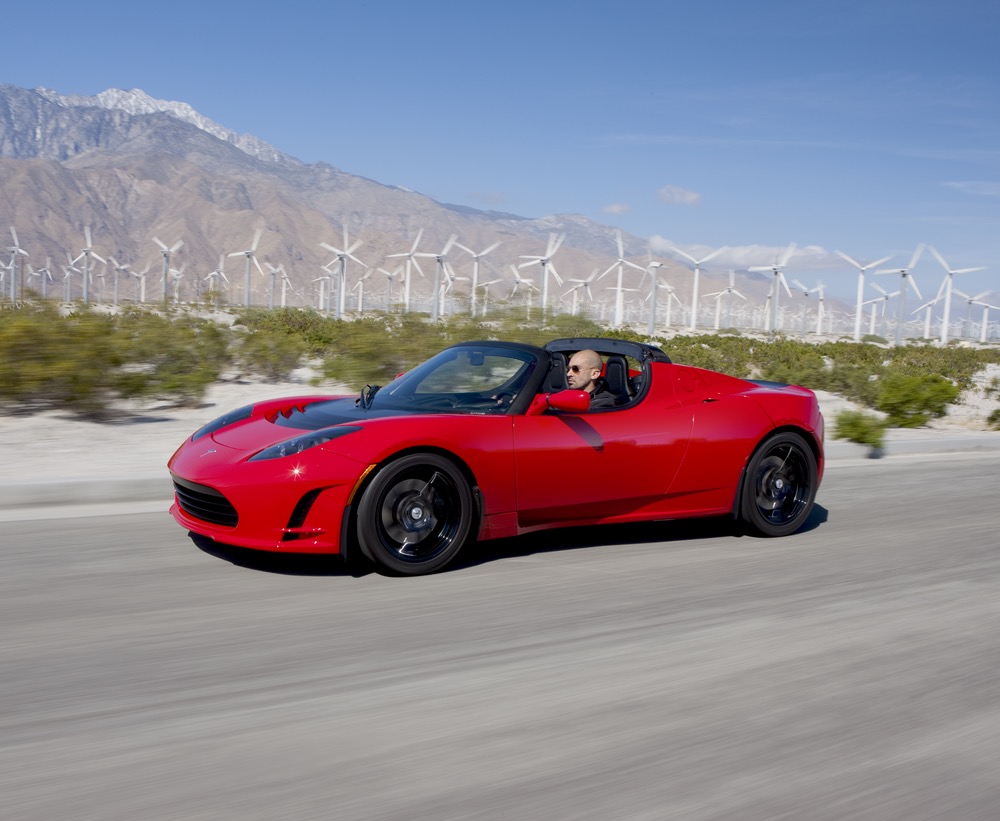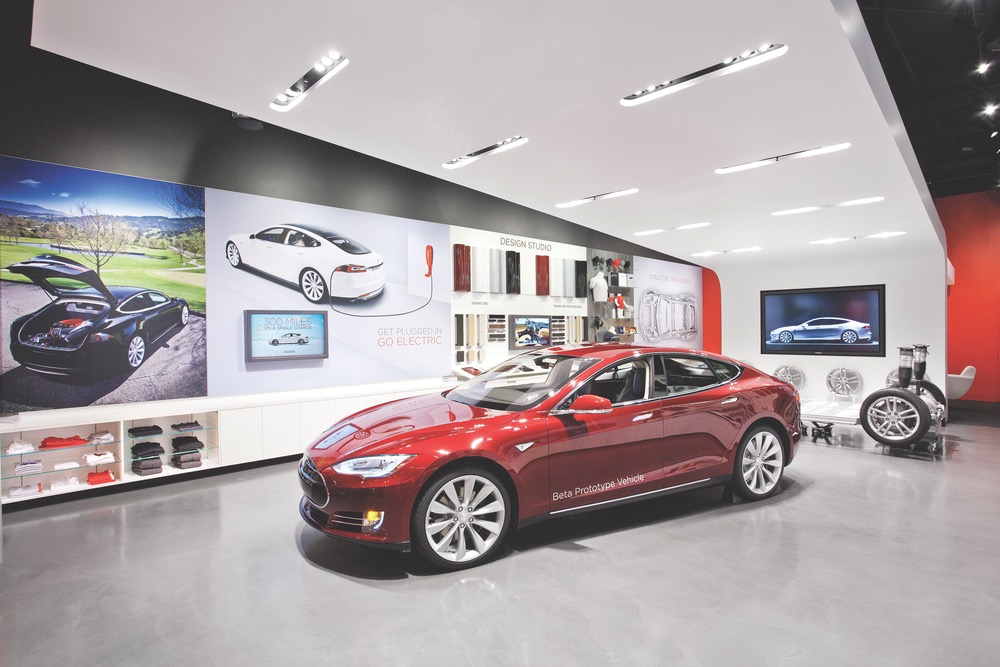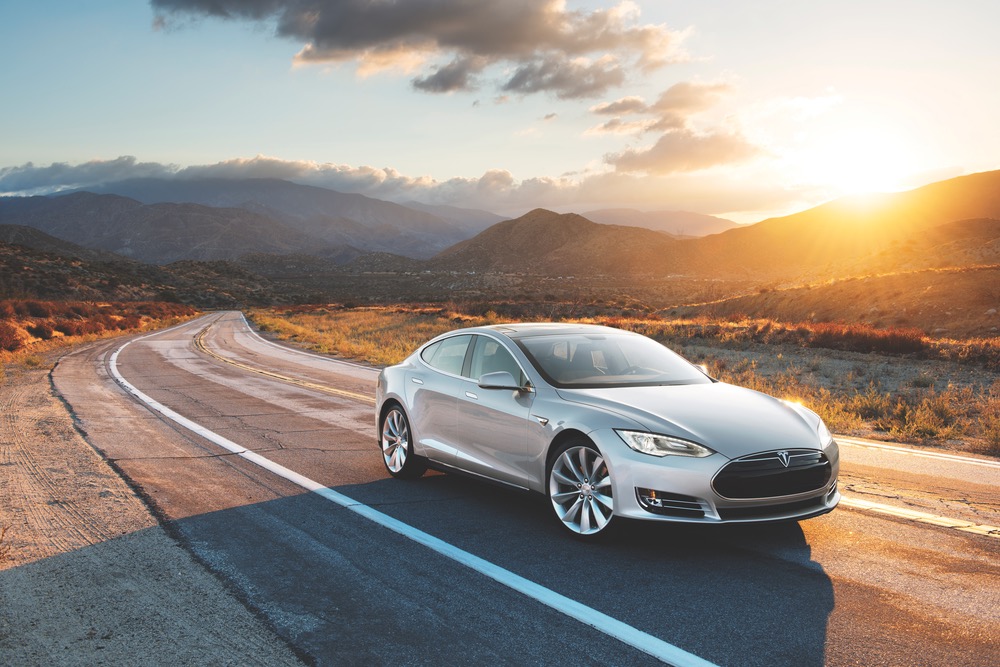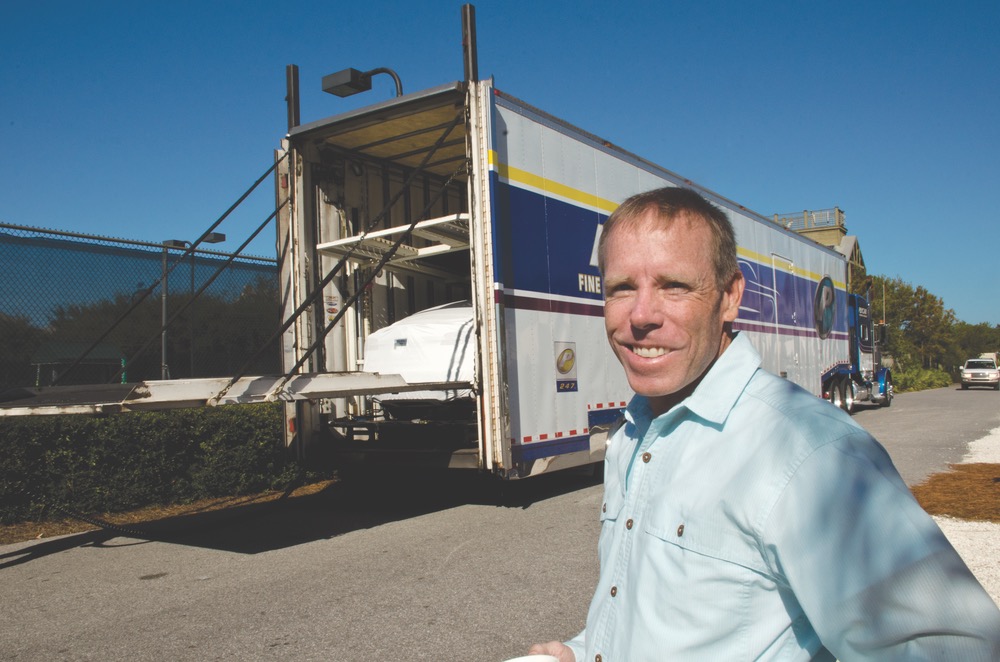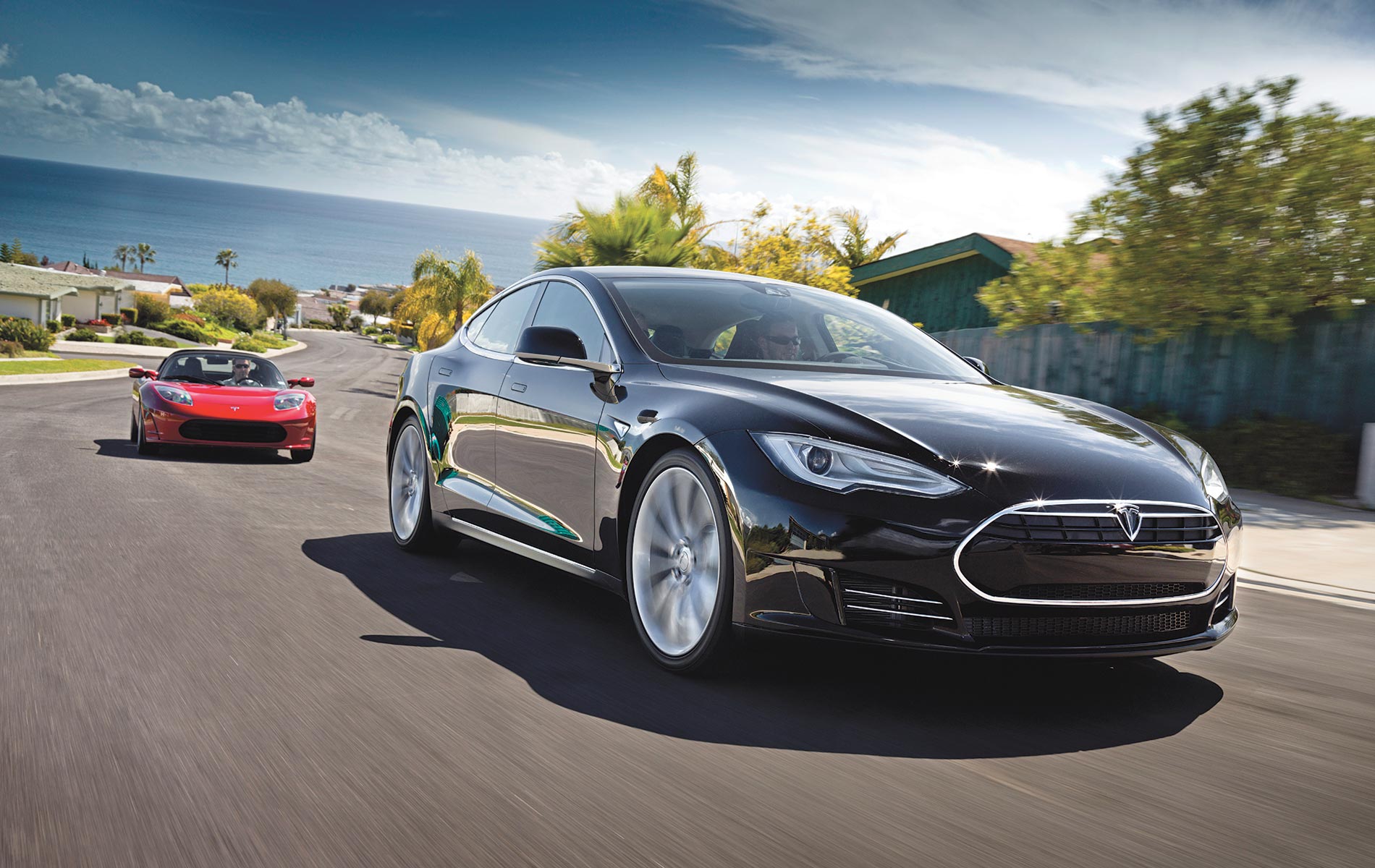
vie-magazine-tesla
Super Fly + Super Charged
By Sallie W. Boyles | Photography by Gerald Burwell/Tesla Motors
What could Dave Rauschkolb, the owner of Northwest Florida’s Bud & Alley’s Restaurant, and Elon Musk, the CEO of SpaceX, a California maker of space rockets, have in common? Creating a dining experience that becomes a family tradition and designing spaceships that transport families to Mars are certainly eons apart in terms of career paths, but Rauschkolb and Musk are driven by at least one shared vision: to shift the world’s reliance on cars that run on fossil fuels to a global demand for electric vehicles (EVs).
In light of that vision, Rauschkolb and Musk also have vested interests (albeit at vastly different levels) in the success of Tesla Motors. The California-based car manufacturer, established in 2003, began turning heads with its award-winning, all-electric Roadster (a sporty two-seater) in 2008 and continues with the rollout of the Model S—an American-made, first-in-its-class, full-sized, fully electric, luxury “family” sedan.
“Our effort has been the only EV built from the ground up to be electric,” says Tesla spokeswoman Shanna Hendriks. “We’ve created an amazing experience, and we’re working hard and succeeding at motivating the market to move toward a sustainable solution.”
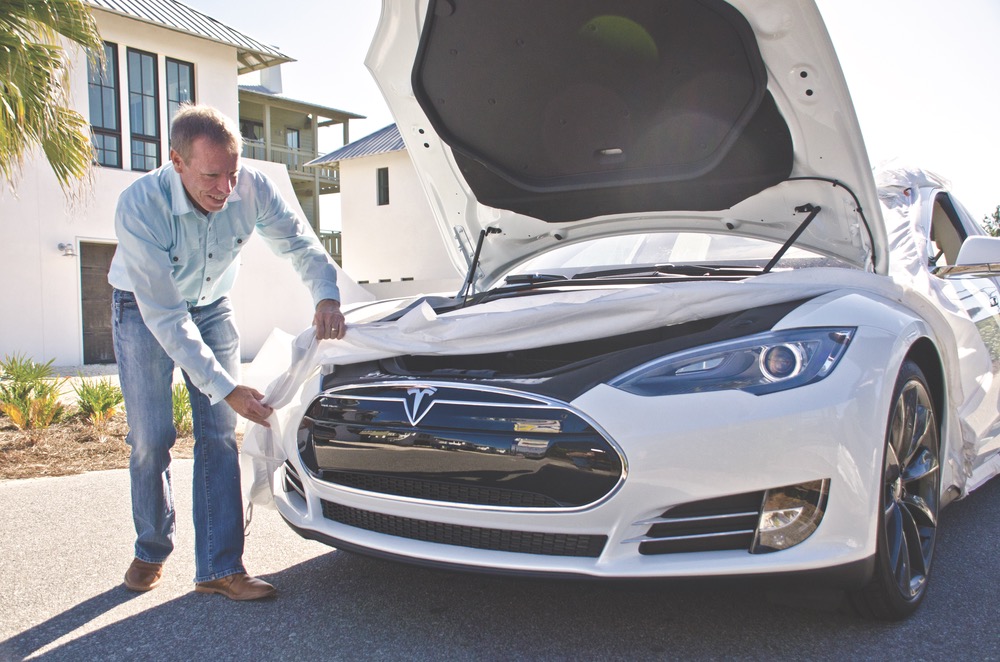
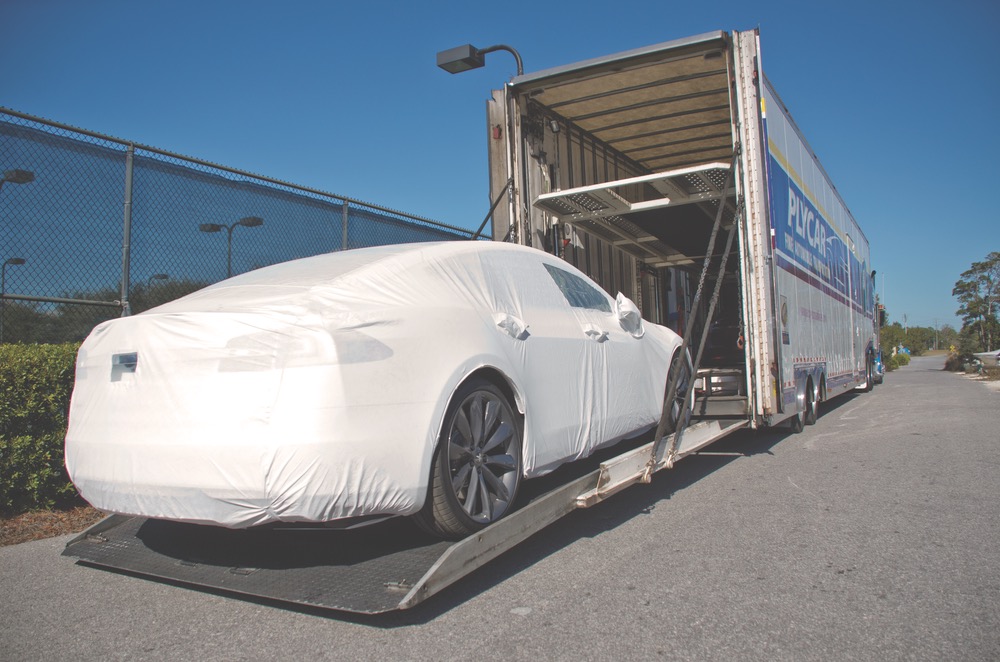
“When I heard about Tesla’s four-door sedan that would go up to three hundred miles on a single charge, I wanted to be first in line,” says Rauschkolb, also a proud early adopter of the all-electric Nissan LEAF. “I was one of the first to order the LEAF and waited patiently, about two years, for my car.”
Rauschkolb’s attraction to electric reflects his environmental stance (continue reading to learn how he has made a splash with a grassroots antidrilling campaign), and he’s downright thrilled to keep money in his pocket that would otherwise pay for fuel. “By not buying gas, I’m saving $3,000 per year,” he says. Having solar panels on his home also helps. “Pretty much everything we buy is dictated by the price of oil,” he continues. “I don’t know about you, but I hate being dependent on anything.”
And so, instead of Christmas in July, Rauschkolb celebrated a special kind of Independence Day at the start of the 2012 Christmas season when, on December 2, his gift to himself arrived. An eighteen-wheeler pulling an enclosed trailer came, as scheduled, to his Florida home with his personally reserved Tesla—number “904” of the 1,200 Model S Signature Performance limited editions made. Presented like an impeccably wrapped present, the car showed up in mint condition along with a Tesla Delivery Experience Specialist’s white-glove, bumper-to-bumper treatment and tutorial.
Considering that the top-of-the-line Model S’s price tag with extras hovers around $100,000, a new owner might expect an abundance of hand-holding. The no-frills model with a standard battery, reserved after January 1, 2013, totals $52,400 after a $7,500 federal tax credit.) For a customer like Rauschkolb, who never so much as test-drove the Model S before taking ownership, learning the nuances of the car is more than a nicety; it’s a necessity. (That’s correct: Rauschkolb, who, like other Tesla buyers, custom-ordered his sedan online, had seen only a beta version of the Model S before receiving his car!) Recognizing that the Model S does not operate like the typical car or even other EVs, buyers who take the leap must get down to learning a brand-new system.
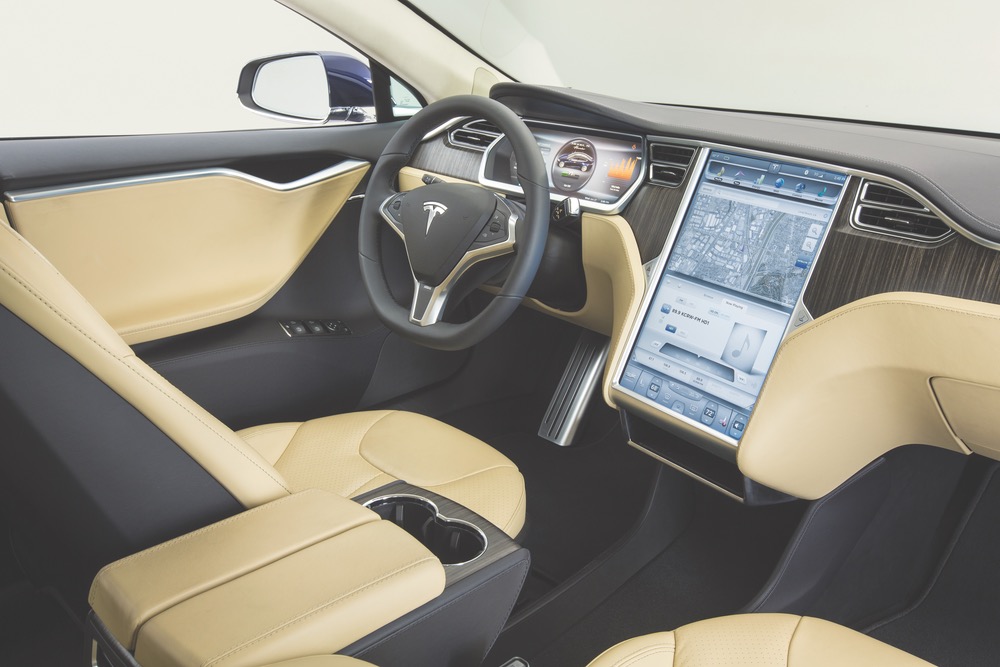
The sleek and luxurious interior of the Model S features supple leather, exotic wood, and high-tech instrumentation, including an oversized touch screen interface in the center console
And how seriously fun and cool that can be! Even critics who’ve scoffed at other EVs for trying to look weird are wowed by a classy, sleek design that grabs attention without pushing the limits. Simply put, if competing in a beauty contest, the Model S would give Maserati, Jaguar, and Aston Martin a run for the money. The car, however, also has brains, which is why the Model S has been named 2013’s “car of the year” by Automobile Magazine, Motor Trend, and Yahoo! Autos. The Model S additionally earned Popular Mechanics’ award for technical innovation and further landed on Time magazine’s Best Inventions of the Year 2012 list.
The innovations are abundant. For starters, the door handles are retractable; they automatically slide out and present to the driver when he or she approaches with a key fob. Instead of a key or start button to ignite the engine, the driver touches the brake. An acceleration pedal replaces the gas pedal, and from that point on, the car is controlled via a seventeen-inch touch screen computer with full connectivity to the web. Located in the center console, the display looks like it belongs in a cockpit.
Operators use the touch screen for everything: Drag and drop an icon to open and close the panoramic sunroof. Raise and lower the body to suit terrain like deep snow or steep inclines. Additionally, a task like charging the car, which is pretty simple in terms of plugging in, comes with programming options. Using a smartphone or the touch screen, the owner can devise a customized charging schedule that takes advantage of off-peak electricity rates.
While the car is charging, the operating system also automatically downloads updates. “They sent an update to my car last night at 1:00 a.m.,” says Rauschkolb. Owners, therefore, benefit from continuing improvements, like voice commands that were lacking in the launch models. The extensive yet intuitive system is enticing. “I’ll have to force myself not to surf the web!” Rauschkolb admits. Accordingly, Yahoo! Autos describes the car as a “computer on wheels.”
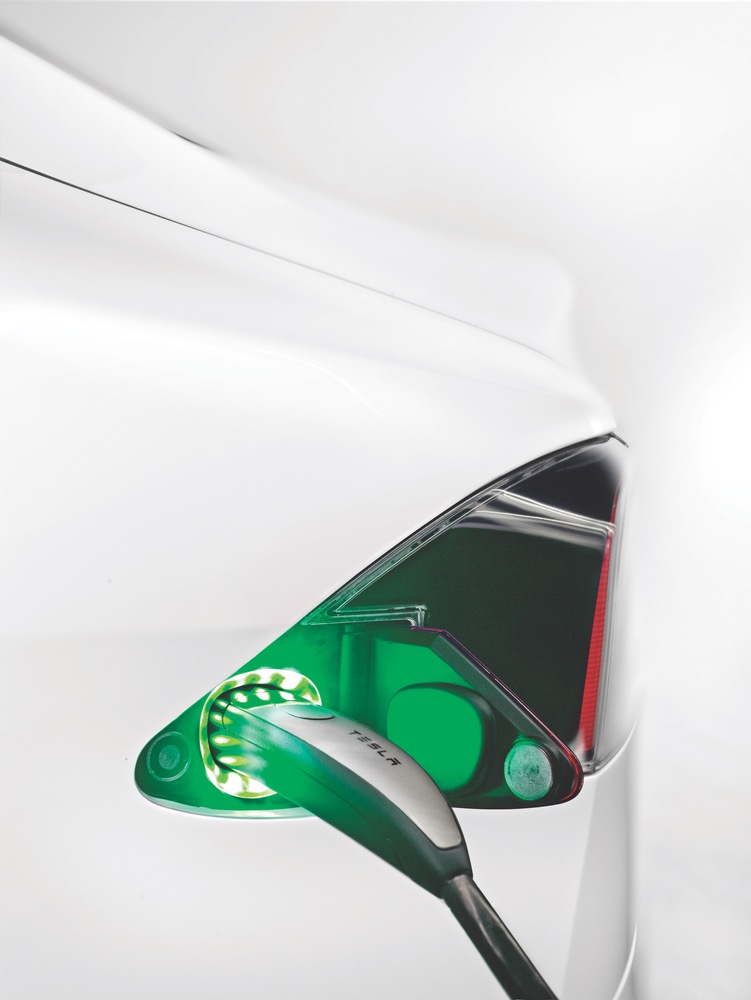
Accordingly, Yahoo! Autos describes the car as a “computer on wheels.”
Those who are new to EVs must also adjust to a novel driving experience. With the absence of an engine and its usual noise, the sounds one hears while in motion are the wind and the tires. “The quiet element is different,” says Rauschkolb, explaining that even his Nissan LEAF makes what he describes as a “high-pitched spaceship sound” during acceleration. The Model S, in comparison, is silent.
Noted to be remarkably smooth and quick, the Model S promises a thrill. Tests have clocked its acceleration from zero to sixty miles per hour in 3.9 seconds—faster than a Lamborghini or a Maserati. “While I was driving on Highway 98 this morning, the car was almost frighteningly fast,” Rauschkolb says of his first wide-open ride. “It was like being in a rocket ship. My tonsils were in the back of my headrest!”
Some feel the powerful torque—that moment of force that causes rotation—in the stomach. “I’m not a speed freak at all,” Rauschkolb adds, “but it’s good to know I have the power; I don’t always have to use it.” In actuality, he claims that driving an EV has conditioned him to slow down to conserve power. Nevertheless, the Model S has enough range to scream for speed!
At any speed, the Model S earns high marks for the way it handles. Automobile Magazine describes its electric power steering as “nuanced and well-weighted.” Drivers further appreciate the control they have when taking sharp corners at high speeds or hitting the brakes. Although the car weighs more than 4,700 pounds, the battery pack is mounted low in the floor pan, adding stability yet maintaining a light suspension over wheels.
Placing the battery pack out of the way plus having no motor allow for a roomy interior with ample front and rear storage compartments. To make use of the extra space, Tesla offers the option of adding a third row of two rear-facing child seats. Thus, the comfortable five-seater becomes a seven-passenger sedan.
At any speed, the Model S earns high marks for the way it handles.
With all of its novel luxuries, the Model S could not take off without a reliable power source. Offered with three battery options (40, 60, and 85 kilowatt-hours), the Model S comes ready to plug into a common 240-volt outlet, a standard 120-volt wall outlet, or a public charging station. With a 240-volt outlet, the car will recharge at a 100-kilometer range per hour. Along with choosing the battery size, buyers can opt for a single or twin charger. Twin chargers recharge the battery in half the time.
Since the Model S’s range is 265 miles with the 85 kWh battery, according to EPA testing under normal driving conditions, Tesla has solved the logistics problem for everyday use. Indeed, a Central Florida University professor is one of the first to prove that his Model S could exceed four hundred miles on a single charge. Although he drove slowly on a carefully planned rural route, the car went 423.5 miles before the Charge Now warning light blinked. “If I had ‘range anxiety,’ to quote an oil industry term,” says Rauschkolb, referring to the fear of running out of power while on the road, “I wouldn’t have it with the Tesla.”
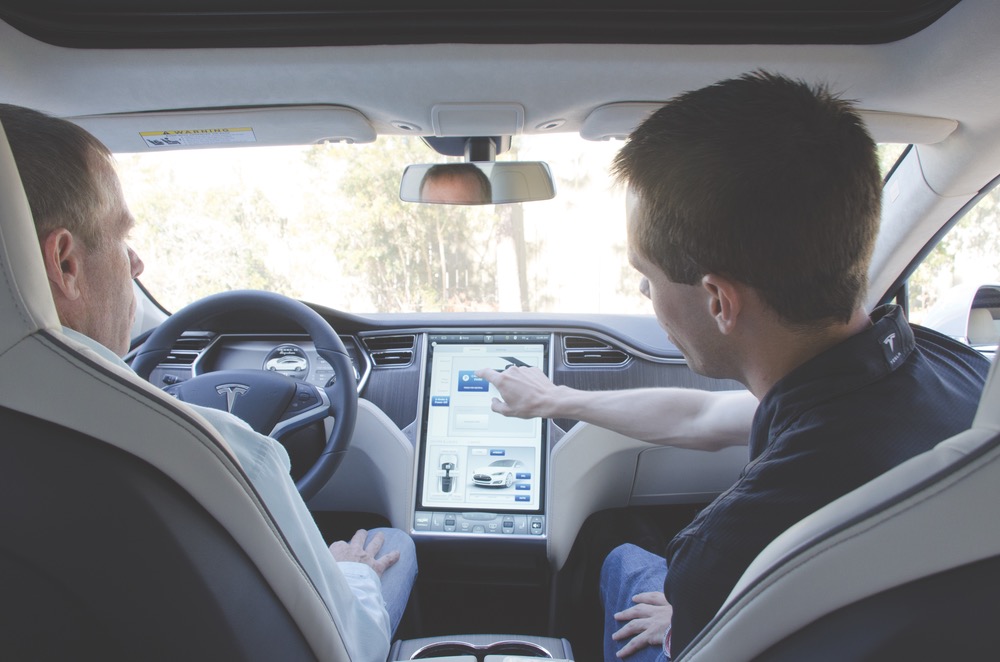
Rauschkolb listens intently while Tesla delivery specialist Ben Bird gives instruction on the car’s instrumentation and key functions
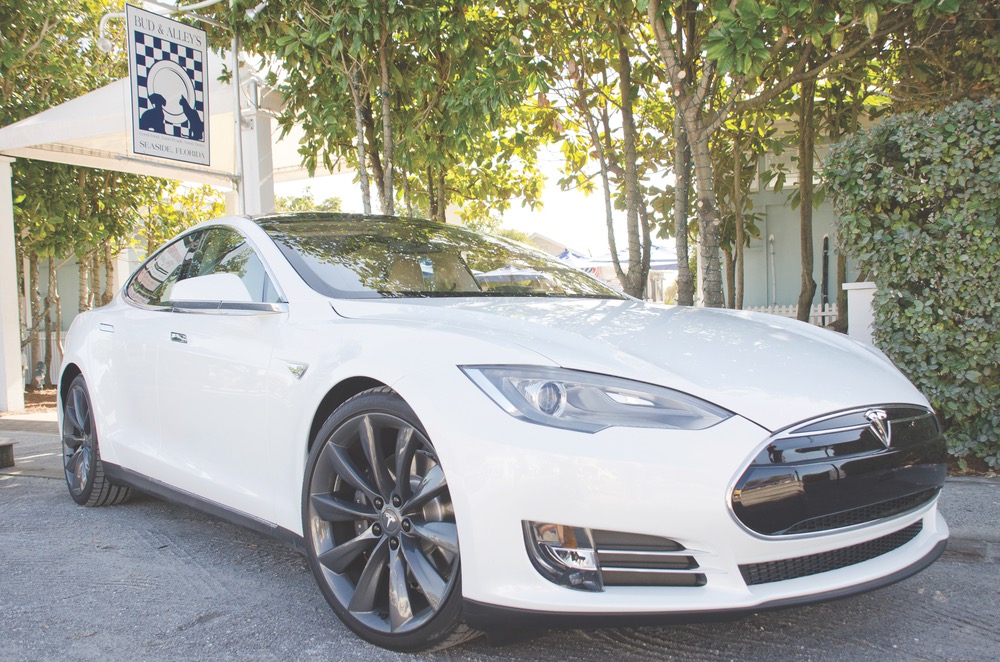
Rauschkolb’s Signature Series Model—number 904 of 1,200 made
Most owners develop a habit of plugging in at night, as many do with their cell phones. Additionally, Tesla Motors has opened six of its own Supercharger stations, the electric alternative to the gas station, in California. The Tesla Supercharger facilitates a 50 percent charge in just thirty minutes. “That’s the time you would take to stop for lunch,” says Rauschkolb. To develop a national infrastructure that supports EVs, the company plans to roll out Tesla Supercharger stations in other states based upon where their owners are clustered. In that effort, Tesla will survey owners by region to determine their driving habits and thereby create station waypoints that best serve their clientele. Tesla drivers may use any Tesla Supercharger station at no cost. “We plan to open one hundred of these stations across North America by the end of 2013,” says Hendriks.
If developing a power station infrastructure seems ambitious, then bypassing the dealer network and opting instead to distribute cars through Tesla-owned boutiques is another example of the management’s innovative thinking. Interestingly, Tesla strategically locates its stores and showrooms in high-foot-traffic areas as a way of generating curiosity and then educating consumers about the brand and EVs. American dealers, by the way, are in an uproar over being left out, and franchise laws in some states prohibit manufacturers from owning dealerships. Still, if customers prefer Tesla’s model, which closely resembles Apple’s approach to retailing, the question becomes just how much ambition can one EV company muster to change the entire game, including the way people buy cars?
The answer stems from Elon Musk, the cofounder who runs Tesla Motors as chairman, product architect, and CEO. If his name sounds familiar, it might be because, besides launching SpaceX, Musk is also the founder of PayPal and the current chairman of SolarCity. He is a visionary who gets things done. While his ideas for revolutionizing space travel might seem “out there,” Musk’s track record includes some history-making milestones with launch vehicles and spacecraft developed by SpaceX, the only private company that has ever returned a spacecraft from low earth orbit. In comparison, an aggressive plan for rolling out EVs and power stations across the continent and beyond seems quite achievable.
Besides, in his role of overseeing the company’s product strategy, Musk has assembled an extraordinary leadership team, prompting even the naysayers to express some faith in this all-EV manufacturer. For instance, JB Straubel, the other cofounder and chief technical officer, has developed electronic systems for the aerospace and car industries, including a long-distance hybrid-electric propulsion concept licensed to Boeing. Other top executives have made impressive inroads at places like Daimler, Ford, Mazda, Toyota, Google, The Gap, Apple, and the U.S. State Department. Daimler and Toyota, in fact, have partnered with Tesla for its powertrain technology.
Plenty could be written about Tesla’s potential, but the story, for now, returns to reasons why Dave Rauschkolb was determined to be one of the first one thousand owners of the Tesla Model S. He bought the car not to show off, but to walk the walk and show others, surely upscale movers and shakers, that they, too, can lead the way by purchasing an EV without sacrificing luxury.
Rauschkolb understands why people don’t like to give up life’s pleasures. He admits being more interested in surfing than running a restaurant when the opportunity to open Bud & Alley’s came along about twenty-seven years ago. That’s why he and his surfing buddy and then-partner, Scott Witcoski, sealed the deal with a pledge to do both.
“The proposed site at Seaside looked like it would be fun,” says Rauschkolb. They could surf right outside the restaurant. “We made sure we got in the water; we even closed one month of the year to go on surfing trips to places like Costa Rica and the South of France.” He wasn’t opposed to work as long as he could play. “My father was diagnosed with lung cancer at an early age,” Rauschkolb explains, “so I was determined to have lots of fun in my youth in case the same thing happened to me.”
Understandably, Rauschkolb’s love and respect for the Gulf of Mexico run deep. “From the time I was twelve,” he says, “I remember my dad taking me fishing, and the first sport I did well as a teen was surfing. It allows me to be one with the water, and even when the waves are big and nasty and scary, it’s a pristine, beautiful, wondrous environment. My passion for the Gulf came from that, but everyone who chooses to live or visit here is passionate. Families and their memories are tied to the Gulf of Mexico—the water, the sea life, the weather. The thought of oil leaks violating our beloved and sacred waters was always abhorrent to me.”
Even so, he had no plans to be an antidrilling activist—at least not until politics provoked him. In the spring of 2009, Florida’s House of Representatives voted to lift bans on near-shore oil drilling. Rauschkolb learned of the legislation in late September, when friend and local attorney, David Pleat, informed him that the changes were pending approval by Florida’s Senate. “From going to places like Biloxi as a child and seeing the oil rigs close to shore there, the idea of near-shore drilling off our coast made me sick,” Rauschkolb says.

Rauschkolb, a surfing enthusiast, has surfed exotic places such as Costa Rica and the South of France
The impetus to act came on October 1, 2009, when Rauschkolb hosted an event at Bud & Alley’s for Pleat to announce his run for a seat in Florida’s House of Representatives. Pleat gave an impassioned speech about “taking a stand” against the drilling initiative. His message prompted Rauschkolb to say, “We need to draw a line in the sand.” The words “draw a line in the sand” stuck in Rauschkolb’s brain. By the end of the evening, he told his wife, Carol, “I know what we can do!” His vision for Hands Across the Sand developed from there.
Described as a “movement … of people of all walks of life and … all political affiliations and borders of the world,” Hands Across the Sand organizes gatherings of individuals along coastlines and other places of significance. A seemingly endless line of people joining hands creates a poignant visual.
At the first demonstration on Saturday, February 13, 2010, ten thousand Floridians of all ages, from Pensacola to Key West, stood hand in hand to protest proposed state and federal legislation that would affect Florida’s coast. “We got tons of press,” says Rauschkolb of what became the largest demonstration against drilling in the state’s history. Regrettably, a catastrophe, more so than the success of the initial protest, fueled many more to join his cause: the Deepwater Horizon oil spill, or “the BP oil disaster,” occurred on April 20, 2010.
The episode began with an explosion that killed eleven men working on the oil rig’s platform and continued with the release of about 4.9 million barrels of crude oil into the Gulf of Mexico. The gushing wellhead was capped three months later, on July 15, but reports reveal a persistent seep.
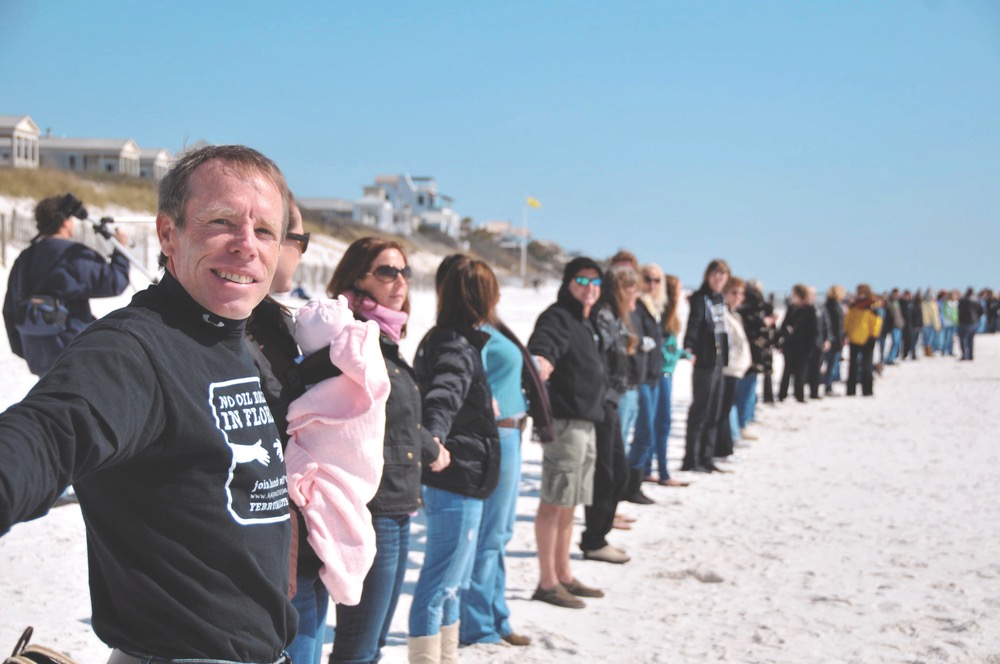
Dave Rauschkolb—found of Hands Across the Sand—draws the line
Whether or not Rauschkolb had a premonition about the disaster that threatened to ruin everything he loves about the coast, he had a structure in place to fight back. Working in conjunction with the Sierra Club, the Surfrider Foundation, 350.org, and other groups, he organized a second Hands Across the Sand event on June 26, 2010. Thanks to social media and coverage gained through a network of environmental organizations, the event turned global. He had to scramble to pull it off. “If you scare yourself out of doing something, you won’t get much done in life,” says Rauschkolb, who was suddenly receiving e-mails from Japan and New Zealand. “I informed our web designer that we needed a translation tool and a world map on the site.”
Amazingly, one thousand events took place across the globe. Individuals from all fifty states, including the District of Columbia and Puerto Rico, as well as from forty-two countries participated in the largest worldwide gathering in history against the expansion of offshore drilling.
“Joining hands sends a powerful political message,” says Rauschkolb. Guided by a mission to end the world’s dependence on dirty fuel sources, Hands Across the Sand events continue, with the next global event scheduled for May 18, 2013. “My next move is coupling Hands Across the Land with Hands Across the Sand,” Rauschkolb states, mentioning hydraulic fracturing (or “fracking”)—a mining method that environmentalists contend can contaminate groundwater—and ending destructive mountaintop mining.
“I don’t have any illusions that we’ll completely end our dependency on oil within our generation,” Rauschkolb says, “but making clean energy the primary source of power for transportation is within our reach. For someone who never intended to become an activist, I see all the good that can come from embracing clean energy, and there’s no turning back. That’s all the more evident now that I have a three-year-old daughter. And I hope her generation is smarter than ours.”
I see all the good that can come from embracing clean energy, and there’s no turning back.
As more consumers begin to follow first adopters like Rauschkolb, he’ll remain cautiously optimistic that the benefits offered by new technologies will gain momentum. For now, he couldn’t be more excited about driving his Tesla.
“I will never buy another gas-powered vehicle,” he concludes.
— V —
Share This Story!
KEEP UP WITH THE LATEST STORIES FROM VIE



